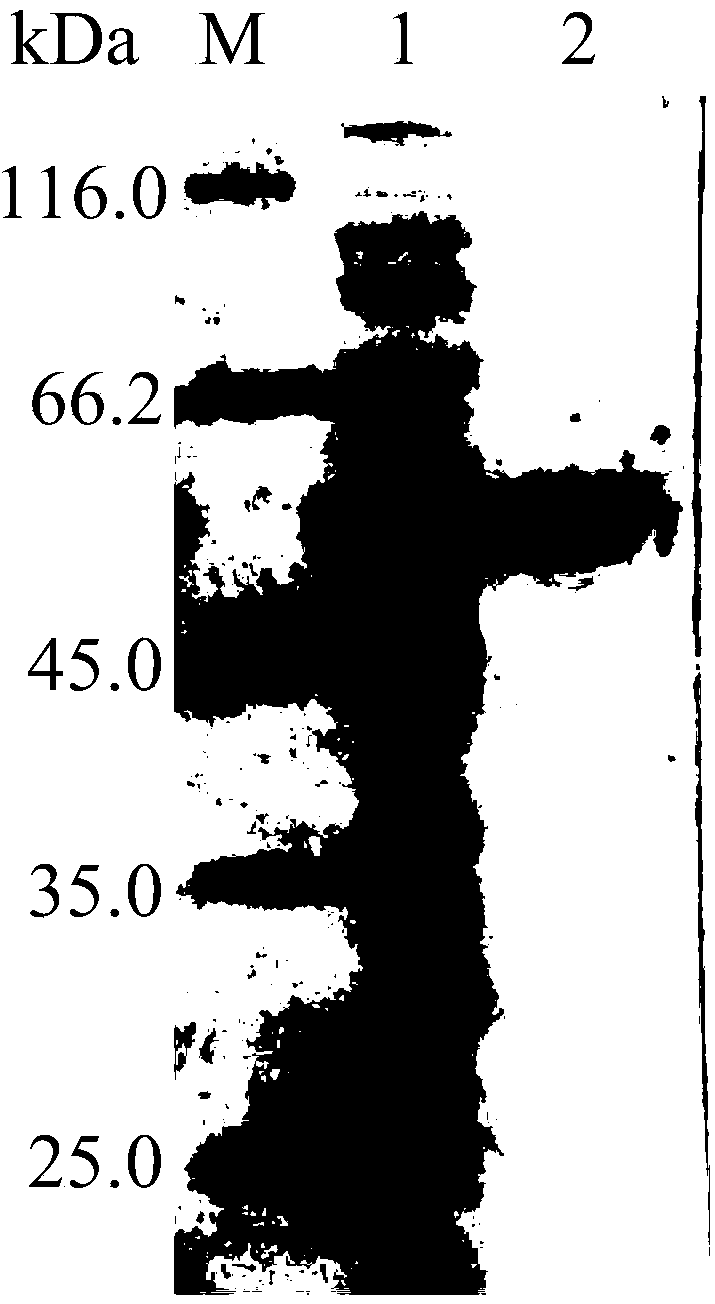Salt-tolerant ethanol-tolerant protease-tolerant surfactant-tolerant exoinulinase, gene thereof, vector and strain
A technology of exo-inulinase and surfactant, which is applied in the field of genetic engineering, can solve the problems of unreported and low enzyme activity, and achieve the effect of good salt resistance, ethanol resistance, protease resistance and surfactant resistance
- Summary
- Abstract
- Description
- Claims
- Application Information
AI Technical Summary
Problems solved by technology
Method used
Image
Examples
Embodiment 1
[0039] Example 1: Cloning of exo-inulinase gene inuAJB13
[0040] Extract the genomic DNA of Sphingomonas: Centrifuge the bacterial liquid cultured for 2 days to get the bacterial cells, add 1mL lysozyme, treat at 37°C for 60min, then add the lysate, the composition of the lyse is: 50mM Tris, 20mM EDTA, Nacl500mM, 2% SDS (w / v), pH 8.0, lysed in a water bath at 70°C for 60 minutes, mixed every 10 minutes, and centrifuged at 10,000 rpm for 5 minutes at 4°C. The supernatant was extracted in phenol / chloroform to remove impurity proteins, and then an equal volume of isopropanol was added to the supernatant. After standing at room temperature for 5 minutes, centrifuge at 10,000 rpm for 10 minutes at 4°C. The supernatant was discarded, the precipitate was washed twice with 70% ethanol, dried in vacuo, dissolved by adding an appropriate amount of TE, and stored at -20°C for later use.
[0041] Table 1. Cloning and expression primers of exo-inulinase gene inuAJB13
[0042]
[0043...
Embodiment 2
[0045] Embodiment 2: Preparation of recombinant exo-inulinase InuAJB13
[0046] Using inuAJB13F and inuAJB13R as a primer pair (Table 1) and Sphingomonas genomic DNA as a template, PCR amplification was performed. The parameters of the PCR reaction were: denaturation at 94°C for 5 min; then denaturation at 94°C for 30 sec, annealing at 61°C for 30 sec, extension at 72°C for 1 min and 30 sec, and after 30 cycles, incubation at 72°C for 10 min. According to the results of PCR, the exo-inulinase gene inuAJB13 was obtained, and a protruding A base was introduced at the 3' end of the gene. The exo-inuAJB13 gene inuAJB13 and the expression vector pEasy-E2 were connected by T-A method to obtain the recombinant expression plasmid pEasy-E2-inuAJB13 containing inuAJB13. Transform pEasy-E2-inuAJB13 into E. coli BL21(DE3) to obtain recombinant E. coli strain BL21(DE3) / inuAJB13.
[0047] Take the recombinant Escherichia coli strain BL21(DE3) / inuAJB13 containing the recombinant plasmid pE...
Embodiment 3
[0048] Example 3: Determination of the properties of the purified recombinant exo-inulinase InuAJB13
[0049] 1. Activity analysis of purified recombinant exo-inulinase InuAJB13:
[0050] Example 2 The activity determination method of the purified recombinant exo-inulinase InuAJB13 adopts the 3,5-dinitrosalicylic acid (DNS) method: the substrate is dissolved in 0.1M buffer to make the final concentration 0.5% (w / v); the reaction system contains 100 μL of appropriately diluted enzyme solution and 900 μL of substrate; after the substrate is preheated at the reaction temperature for 5 minutes, add the enzyme solution and react for 10 minutes, then add 1.5mL DNS to terminate the reaction, boil in water for 5 minutes, and cool After reaching room temperature, measure the OD value at a wavelength of 540nm; 1 enzyme activity unit (U) is defined as the amount of enzyme required to decompose the substrate to produce 1 μmol reducing sugar (calculated as fructose) per minute under given ...
PUM
 Login to View More
Login to View More Abstract
Description
Claims
Application Information
 Login to View More
Login to View More - R&D
- Intellectual Property
- Life Sciences
- Materials
- Tech Scout
- Unparalleled Data Quality
- Higher Quality Content
- 60% Fewer Hallucinations
Browse by: Latest US Patents, China's latest patents, Technical Efficacy Thesaurus, Application Domain, Technology Topic, Popular Technical Reports.
© 2025 PatSnap. All rights reserved.Legal|Privacy policy|Modern Slavery Act Transparency Statement|Sitemap|About US| Contact US: help@patsnap.com



